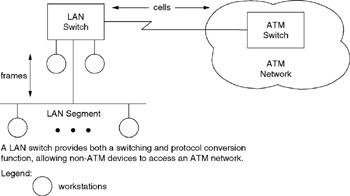2.7 The Physical Layer
2.7 The Physical Layer
Although Figure 2.15 and Figure 2.16 illustrate an ATM physical layer, a specific physical layer is not defined within the protocol stack. Instead, ATM uses the interfaces to existing physical layers defined in other protocols, which enables organizations to construct ATM networks on different types of physical interfaces and, in turn , connect to different types of media. Thus, the omission of a formal physical layer specification results in a significant degree of flexibility that enhances the capability of ATM to operate on LANs and WANs.
2.7.1 ATM Operation
As previously discussed, ATM represents a cell -switching technology that can operate at speeds ranging from T1's 1.544 Mbps to the gigabit-per-second rate of SONET. In doing so, the lack of a specific physical layer definition means that ATM can be used on many types of physical layers, which makes it a very versatile technology.
2.7.2 Components
ATM networks are constructed on the use of five main hardware components. Those components include ATM network interface cards, LAN switches, ATM routers, ATM WAN switches, and ATM service processors.
2.7.2.1 ATM Network Interface Card
An ATM network interface card (NIC) is used to connect a LAN-based workstation to an ATM LAN switch. The NIC converts data generated by the workstation into cells that are transmitted to the ATM LAN switch and converts cells received from the switch into a data format recognizable by the workstation.
2.7.2.2 LAN Switch
A LAN switch is a device used to provide interoperability between older LANs, such as Ethernet, Token Ring, or FDDI, as well as from those networks to ATM. To provide connectivity to ATM, the LAN switch supports a minimum of two types of interfaces, with one being an ATM interface that enables the switch to be connected to an ATM switch that forms the backbone of the ATM infrastructure. The other interface or interfaces represent connections to older types of LANs.
The LAN switch functions as both a switch and protocol converter. Data received on one port destined to the ATM network is converted from frames to cells and transferred to the switch port providing a connection to the ATM switch. One of the key functions that must be performed by the switch in conjunction with the ATM switch it is connected to is a mapping between the MAC addresses used on a LAN switch and the virtual path /virtual channel (VP/VC) identifiers used by ATM. This mapping process is accomplished through a technology known as LAN Emulation (LANE), which is described in Chapter 9, Section 9.2.
Because one LAN switch port can be capable of servicing a LAN segment, the use of a switch can minimize an organization's investment in ATM NICs. Figure 2.17 illustrates the use of a LAN switch with a single ATM port to provide access to an ATM network for individual workstations connected directly to individual switch ports as well as a group of workstations on a LAN segment. Through the use of the LAN switch, an organization can selectively upgrade existing LANs to ATM while obtaining a connection to the ATM network.

Figure 2.17: Using a LAN Switch
2.7.2.3 ATM Router
An ATM router, or perhaps a more correct terminology, an ATM supportable router, is a router containing one or more ATM NICs. As such, it can provide a direct or indirect capability for LAN workstations to access an ATM network or for two ATM networks to be interconnected . For example, a network segment or individual workstations could be connected to a router, which in turn is connected to a LAN switch or directly to an ATM switch.
2.7.2.4 ATM Switch
An ATM switch is a multi-port device that forms the basic infrastructure for an ATM network. Unlike a LAN switch, an ATM switch only permits a single end station to be connected to each switch port. By interconnecting ATM switches, an ATM network can be constructed to span a building, city, country, or the globe.
The basic operation of an ATM switch is to route cells from an input port onto an appropriate output port. To accomplish this, the switch examines fields within each cell header and uses that information, in conjunction with table information maintained in the switch, to route cells. Later in this section we examine the composition of the ATM cell header in detail.
One of the key features of ATM switches reaching the market during the late 1990s was their rate adaptation capability, which in general is a function of the transmission media used to connect endpoints and to connect switches to other switches. Table 2.9 lists some of the communications rates associated with different transmission media.
| Operating Rate (Mbps) | Transmission Media |
|---|---|
| 25 “51 | Unshielded twisted pair category 3 |
| 100 | Multi-mode fiber |
| 155 | Shielded twisted pair |
| 622 | Single-mode fiber |
2.7.2.5 ATM Service Processor
An ATM service processor is a computer operating software or firmware embedded in an ATM switch that performs services required for ATM network operations. For example, an ATM network address can have one of three formats, with one format similar to a telephone number. In comparison, the NIC in an IEEE 802 standardized LAN has a hardware (MAC) address burnt into the adapter. Stations on a LAN can register their addresses using the facilities of a LAN Emulation Server (LES). That server would then act as a translator between the burntin LAN specific hardware addresses and ATM public or private network addresses that could considerably differ from the LAN addressing scheme. The LAN Emulation process, to include a description of the operation of the LES, is described in the LAN Emulation section in Chapter 9.
EAN: 2147483647
Pages: 111